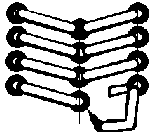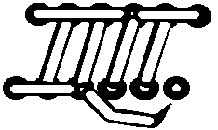
| Techniques and Patterns to Attach Quills to Birch Bark |
|
INSERTING A QUILL THROUGH BARK |

| Techniques and Patterns to Attach Quills to Birch Bark |
|
INSERTING A QUILL THROUGH BARK |

|
The satin pattern is used
to fill areas is similar to that of the satin stitch used in embroidery.
Sets of holes and the inserted quills are placed parallel to
each other. In filling large areas with this stitch, the perforations
are often stepped slightly in a zig-zag to avoid making weak areas
by too many lines of holes in the bark.
|

|
The chevron pattern arranges
quills in a zig-zags. Often the second quill set at an angle
to the first quill will share one of the holes with the first
quill so there is no space or interruption in the design.
|

|
The Outline pattern is
used to form feathery curved lines like those for plant stems
and they are made by slightly starting the next pair of perforations
halfway between, and to the side of, the last pair of perforations.
|

|
The running-stitch pattern
creates thin straight stitches. After the first quill is placed
through the first set of holes, only one new perforation is made
through which the new quill which is threaded, and then the new
quill passes through the second perforation of the first pair.
|

|
A cover-stitch pattern
is like the running-stitch and is sometimes used to 'neaten up'
a line of perforations or to emphasize certain lines of the design.
The quill is placed through a hole in the end of a line of holes,
is laid over the ends of the quills in the row, and passes back
through the hole at the other end of the line. Several cover stitches
must be taken over curved lines of holes, with each quill covering
three or four holes.
|

|
Quills can be arranged in rays using
the fan pattern. All the quills on the tapered
end of the fan pass through the same hole, while at the opposite
end the individual quills pass through evenly spaced separate
holes.
|

|
Using a variation of the lattice
pattern, a small raised star can be achieved by repeatedly
crossing quills over each other at their center point. A circle
of 8 or 12 holes formed by the holes punched through the bark.
Each quill is 'stapled' through the perforations at the opposite
side of the circle. Sometimes the quills are crossed so that
the last quill placed appears to bind all the others at the center.
|
The basic stitch and variations of the
fan stitch can also be used in various combinations to achieve
woven and 3-D effects. | |
Porcupine Quillwork Bibliography and Books to Buy On-Line
Return to NativeTech's Main Porcupine Quillwork Menu

|
Text and Graphics
© 1994 - Tara Prindle unless otherwise cited. |